
TOP 10 Diseases Part 1 of 10: Heart Matters.
TOP 10 Diseases Part 2 of 10: Cancer Wars.
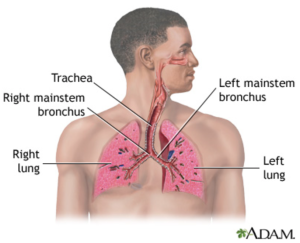 The third leading cause of death in the U.S. and the fifth leading cause of death worldwide is Chronic Obstructive Pulmonary Disease (COPD). The condition is not itself a disease. It is the generic name for a cluster of lung diseases which together cause the symptoms listed below in The Top 8 Respiratory Illnesses and Diseases. The National Emphysema Foundation states that 3.1 million Americans have emphysema while 11.2 million have been officially diagnosed with COPD. It costs the United States nearly $50 billion dollars every year and represents a full three percent of all healthcare costs incurred in Europe.
The third leading cause of death in the U.S. and the fifth leading cause of death worldwide is Chronic Obstructive Pulmonary Disease (COPD). The condition is not itself a disease. It is the generic name for a cluster of lung diseases which together cause the symptoms listed below in The Top 8 Respiratory Illnesses and Diseases. The National Emphysema Foundation states that 3.1 million Americans have emphysema while 11.2 million have been officially diagnosed with COPD. It costs the United States nearly $50 billion dollars every year and represents a full three percent of all healthcare costs incurred in Europe.
COPD, is a serious and progressive disease that makes it difficult to breathe. COPD is a long-term (chronic) illness. This respiratory disease is characterized by an abnormal inflammatory response in the lungs and restricted airflow, which both result in difficulty doing the most vital thing in life — breathing. More than 11 million people in the U.S. are diagnosed with COPD, while an estimated 24 million may have the disease without even realizing it. Most people with COPD aren’t diagnosed until at least 50 percent of their lung capacity is gone.

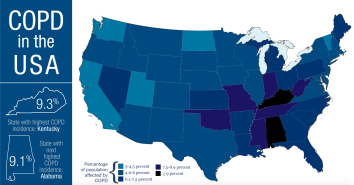
This degree of damage makes it an uphill battle for recovery. Knowing the pathway or symptoms at an earlier stage can help prevent COPD. Deficiency of trypsin enzyme, trypsin inhibitor that protects against protease remodelling in the airway, accounts for 2% of COPD in the population. Recently, gene receptors, interacting proteins, and iron regulatory proteins, have been shown to be potential susceptibile for some COPD genetic risk factors. Conventional medicine considers COPD to be incurable, progressive, irreversible, and fatal, that there is no way to repair the airways and lungs damaged by the disease. I agree that it is a disease that does not have a permanent cure if one follows the western pharmaceutical paradigm and lifestyle. However, there is another side to the story. There is hope to reverse and improve this condition and live your best life ever now, given the fact that our bodies were created to heal themselves if given the conditions to do so. New studies reveal lung tissue can be Regenerated.
There are actually two main forms of COPD:
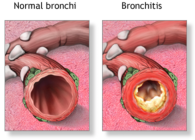 1. Chronic Bronchitis: According to the Mayo clinic, chronic bronchitis is characterized by chronic inflammation of the lining of the bronchial tubes, which are the primary vehicle for air transport in (oxygen) and out (CO2) of the lungs. Common symptoms include: shortness of breath (“dyspnea”), thickening and narrowing of the airway lining, constant coughing to remove copious amounts of difficult to expel phlegm, wheezing and fatigue. Chest infections are common. Acute bronchitis is an infection caused by a virus.
1. Chronic Bronchitis: According to the Mayo clinic, chronic bronchitis is characterized by chronic inflammation of the lining of the bronchial tubes, which are the primary vehicle for air transport in (oxygen) and out (CO2) of the lungs. Common symptoms include: shortness of breath (“dyspnea”), thickening and narrowing of the airway lining, constant coughing to remove copious amounts of difficult to expel phlegm, wheezing and fatigue. Chest infections are common. Acute bronchitis is an infection caused by a virus.
 2. Emphysema: Emphysema involves the gradual destruction of the small, air sacs (alveoli) located at the tip of the smallest air passages (bronchioles). Overtime the walls of the air sacs are destroyed resulting in “holes” leaving fewer and larger air sacs which diminish the gas exchanged in the lungs leading to dyspnea, fatigue, and early death.
2. Emphysema: Emphysema involves the gradual destruction of the small, air sacs (alveoli) located at the tip of the smallest air passages (bronchioles). Overtime the walls of the air sacs are destroyed resulting in “holes” leaving fewer and larger air sacs which diminish the gas exchanged in the lungs leading to dyspnea, fatigue, and early death.
Most people with COPD have a combination of both conditions.

Asthma: Asthma (AZ-ma) is a chronic lung disease that causes inflamed narrowed airways.
Asthma symptoms include wheezing, chest tightness, shortness of breath, and coughing. More than 25 million people in the US have been diagnosed with asthma and approximately 7 million are children. Over time, chronic inflammation can destroy the surface layer of the airways.
The Top 8 Respiratory Illnesses and Diseases
- Asthma – Around 25 million people suffer from asthma, 7 million of which are children.
- COPD – It is estimated that over 24 million people currently have COPD but around half of them don’t know it.
- Bronchitis
- Emphysema – The most common cause is smoking.
- Lung Cancer – This cancer is the leading cause of death for men and women in the United States.
- Cystic Fibrosis – This genetic respiratory disease is caused by a defective gene that creates thick and sticky mucus. This disease affects 30,000 people in the United States, 75% of which were diagnosed by the age of two.
- Pneumonia – This lung disease is caused by an infection in the air sacs in the lungs caused by bacteria, a virus or a fungi.
- Allergies – This condition is one of the most common chronic problems world-wide. Allergies occur when the immune system mistakes a common substance as an invader. The most common culprits of allergic reactions are pollen, dust, food, insect stings, animal dander, mold, medications and latex.
Cigarette smoking is either a cause or an exacerbator of every respiratory disease on this list. It is the leading cause of a preventable illness and death and produces 443,000 deaths a year, around 49,000 of which are caused by secondhand smoke.

“Secondhand smoke can kill. Too many Americans, and especially too many American children, are still exposed to it,” said CDC Director Tom Frieden, M.D., M.P.H.
Common Culprit: Smoking
The No. 1 reason someone gets COPD in developed countries is smoking tobacco, so the best way to avoid COPD is not to smoke or stop smoking immediately. Sadly, close to half of U.S. adults over the age of 40 who have trouble breathing due to asthma or COPD still continue to smoke.
According to the National Cancer Institute, 90% of the men and 80% of the women who died from lung cancer were smokers.

Another hidden danger is that of grilling meats. Barbecue smoke contains polycyclic aromatic hydrocarbons (PAHs), toxic chemicals that can damage your lungs. Charred marks in grilled meat look appealing and give a tasty flavor, but is laden with cancer-causing compounds called heterocyclic amines (HCAs) that form when meat and high heat are combined to create a blackened crust. The more char that’s created, the more carcinogens result that coat your food. High levels of HCAs can cause cancer and epidemiological studies show that eating charred meats may be associated with an increased risk of colorectal, pancreatic, and prostate cancer.
Other Causes
- Exposure to certain gases or fumes in the workplace
- Exposure to heavy amounts of secondhand smoke and pollution
- Frequent use of a cooking fire without proper ventilation
10 Natural Treatments for COPD Symptoms
- Quit smoking – this includes the electronic cigarette. Outsmart smoking triggers: clean, drink water, go for a walk, start a new hobby.
What type of smokers are there? Cool Smokers. Pull the all-nighter Smokers. Fear of telling the truth. Midlife crisis. Skinny Smoker. Social Smoker. Stressful Smoker. Sneaky smoker. Rebel Smoker and more.
2. Follow a Healthy Diet – Citrus fruits are especially helpful because they contain quercetin. Flaxseeds and chia seeds, along with other omega-3 foods, can provide anti-inflammatory omega-3 fatty acids.
A Nutrient-Dense Diet – As more people suffer from chronic lung disease and more studies are conducted to find ways to improve the quality of patients’ lives, the discovery is of a correlation between nutrition and the severity of COPD.
If you’re suffering with COPD symptoms, you definitely want to steer clear of conventional dairy since pasteurized dairy is mucus-producing and can plug the airways in the lungs. You always want to stay away from processed, canned and some frozen foods and sugar as well. Additives, preservatives and food dyes are also known for contributing to breathing issues and even asthma attacks.
3. Improve Your Breathing – physiologically, 96% of our nutritional need comes from oxygen.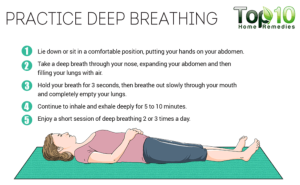

“Take a deep breath in.” (Breath along with this GIF) Inhale specifically through your nostrils and not your mouth. Nasal breathing plays a pivotal role in coordinating electrical brain signals in the olfactory “smell” cortex, is closely linked to the limbic brain regions that affect emotion, memory, and behaviour, which is why sometimes a particular smell or fragrance can evoke very strong emotional memories. Nasal Breathing Influences the Brain. Our in-breath is like a remote control for our brains.
There are techniques for breathing that can help you breathe more efficiently with COPD. Increase oxygen around you with good air, add plants and oils to purify the air.
We know that slow, deep breathing can calm the nervous system by reducing our heart rate and activating the parasympathetic (calming) nervous system.
4. Exercise
a. Exercise might seem like a terrible idea, but being sedentary won’t do anything to help your COPD symptoms. By regularly getting exercise, especially cardio workouts, you can strengthen your respiratory muscles and improve your overall endurance.
b. Exercise also increases endorphin levels, which improves mood, reduces depression and anxiety, and makes it easier to quit smoking. The six-minute walk test (6MWT) was originally used for evaluating exercise tolerance in people with chronic lung disease and heart failure. The 6MWT measures the distance you can walk over a total of six minutes on a hard, flat surface.
5. Increase Water Intake Inside and Outside the Body
a. Internally improve the mucus problem is by drinking plenty of water throughout the day. Drink at least eight glasses of water daily to thin mucus and to stay hydrated.
b. Externally, you can increase the moisture content of the air in your home by using a humidifier.
6. Avoid Cold Places and Crowds – cCold air can trigger bronchospasm, a sudden constriction in the muscles of airway walls that leads to shortness of breath. The less you’re in big crowds the lower your risk of being exposed to infectious germs.
7. Stay Away From Chemicals – Perfumes, scented candles or insect spray, hairspray.
8. Natural Household Cleaners: Homemade Melaleuca Lemon Household Cleaner (use glass containers when storing them)
9. Use Eucalyptus Oil – Cineole, the main constituent of eucalyptus essential oil, actually reduced exacerbations in people with COPD. It also reduces dyspnea (shortness of breath), and improves lung function as well as health status overall. Cineole is an active controller and reducer of airway inflammation in COPD.
10. Consume Ginseng – Ginseng is an herbal supplement that improves lung function and also decrease bacteria in the lungs. Panax ginseng and ginsenosides (active components of ginseng) appear to inhibit processes related to the development of COPD.
11. Take N-Acetylcysteine (NAC) – increases glutathione levels and thinning bronchial mucus. Glutathione hands-down is front-line defender against oxidative stress in the respiratory tract. Treating COPD With Glutathione orally via a nebulizer breaks liquids into tiny droplets that can be inhaled. It boosts antioxidant concentrations in the lungs, reduces free radical damage, increases oxygen saturation, and improves pulmonary function.
Key COPD Nutrients to Include in Your Diet:
- Protein strengthen your respiratory muscles
- Fluids thin mucus making it easier to break up and expel
- Calcium strengthening your bones and immune system, but in addition to magnesium, the two regulate lung function, blood clotting and muscle contraction. Vitamin D is equally important, as it is necessary for the absorption of calcium.
- Magnesium is the fuel that makes muscles work. When magnesium is combined with calcium, the two work together to deliver an antihistamine like-effect that reduces the severity of your shortness of breath. It is involved in protein production, muscle contractions, and blood clotting. minerals like magnesium, help reduce inflammation. The recommended daily intake of magnesium for men over the age of 31 is 420 mg and 320 mg for women. Exceptional natural sources of magnesium are dark green vegetables, peas, whole grains, or beans.
- Phosphorus is involved in building and repairing damaged tissues. consume at least 700mg of phosphorus per day through COPD friendly food options.
- Potassium is involved in muscle contractions, healthy heart function, and it helps deliver nerve impulses throughout the body. Consuming potassium daily can lower blood pressure, anxiety, and stress levels.
Certain diuretics cause the kidneys to expel large amounts of potassium from your body. Increase your potassium packed food sources from 1 medium banana (425), ½ cup of cooked pinto beans (400) or lentils (365), oranges (237 mg each), avocados, dates, pears, raisins, prunes, carrots, spinach, or grapefruits to name a few.
- Fiber prevents you from overeating. Fiber helps to move food along in the digestive tract, minimizing bloating and constipation that can further intensify your shortness of breath (breathlessness).
Let’s not forget that the health in your lungs begins in your gut. It might sound strange, but the respiratory system and the digestive system depend on one another for optimal function. The respiratory and digestive systems work together to power the body. A properly functioning respiratory system delivers adequate oxygen to the blood. Because the digestive system breaks down food and uses muscular contractions to move food through the digestive tract, it needs oxygen to function properly. So, Chronic obstructive pulmonary disease (COPD) and inflammatory bowel diseases (IBD) are chronic inflammatory diseases of mucosal tissues that affect the respiratory and gastrointestinal tracts, respectively. In turn, the respiratory system depends on a properly functioning digestive system to provide the fuel it needs to work effectively. Each function of the body depends on other functions, and all parts of the body need fuel and oxygen. They share many similarities in inflammatory pathologies. To help repair the gut, try these supplements: Bio Cleanse and ProBio5
Top inflammatory foods are: sugar, hydrogenated oils and fast foods, conventional grain products (wheat bread, wheat products, and white products), processed foods, GMO foods.
- Vitamin A helps your body fight off possible infections
- Vitamin C is an important vitamin required by your body in order to repair damaged lung tissue.
- Vitamin D provides protection from symptom worsening flare ups (exacerbations), respiratory infections, helps to reduce lung inflammation.
- Vitamin E reduce those free radicals, helping to minimize lung inflammation. Leafy greens, almond butter.
Some of the best foods for natural stress relief include:
- Foods high in B vitamins
- Foods high in calcium and magnesium as relaxing minerals and electrolytes, calcium and magnesium are important for relaxing muscles. 500 mg of magnesium once or twice a day, 2,000–5,000 mg of high-quality fish oil daily. Include 500–1,000 mg of vitamin C several times a day.
- High protein foods foods with protein provide amino acids that are needed for proper neurotransmitter functions: Lentils: 1 cup: 18 grams, Black Beans (and other beans): 1 cup: 15 grams, Goat Cheese (and other raw cheeses): 1 ounce: 7 grams, Almonds (and other nuts): ¼ cup/23 almonds: 5 grams.
- Eggs: 1 large free-range egg: 7 grams
- If you are a meat eater, eat Grass-Fed Beef: 3 ounces: 22 grams,
- Organic Chicken: 3 ounces: 21 grams,
- Bone Broth: 1 serving (¼ cup): 20 grams,
- Wild-Caught Salmon (and other wild fish): 3 ounces: 17 grams.
- Healthy fats and omega-3 fatty acids reduce inflammation and help stabilize moods. Avocado’s and Nuts create creamy dressings and sauces that are calorie-rich and healthy. An Omega 3 supplement to consider is Plexus MegaX. It combines balanced benefits of omega 3, 6, 9, 5 and 7 with no fishy taste.
Treating COPD With Diet
An increased intake of fruit by 100 grams is associated with a 24% lower COPD mortality risk of getting and then eventually dying from COPD. Most importantly, high antioxidant and anti-inflammatory plant foods can help prevent and reverse this condition. Keep carbs to a minimum, but meet your nutrition needs with a wide variety of legumes includes kidney, lima, navy, black, white, pinto, and garbanzo beans (also known as chickpeas); black-eyed peas; and split peas. The more carbs you eat, the more stress is put on your lungs.
Serve wild rice instead of potatoes or macaroni
Mix up a cold salad of three or four types of beans with diced carrots in an oil-free dressing.
Cilantro Three-Bean Salad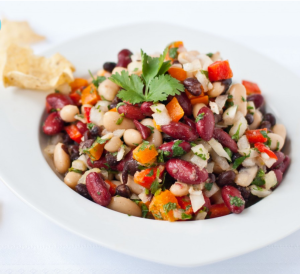
Ingredients
1/2 cup(s) vinegar, cider
3 tablespoon oil, salad
2 teaspoon dark honey/maple syrup
1/4 teaspoon salt
1/4 teaspoon pepper, black ground
1 can(s) beans, garbanzo (chickpeas) (15 ounces) drained and rinsed
1 can(s) beans, white (small) (15 ounces) drained and rinsed
1 package(s) beans, lima (10 ounces) thawed
3 medium carrot(s) coarsely chopped
.3333 cup(s) cilantro
cilantro
1 pepper(s), jalapeno seeded and finely chopped
Instructions
1. For dressing, in a large bowl, whisk together cider vinegar, oil, honey/maple syrup, salt, and pepper. Stir in garbanzo beans, white beans, lima beans, carrots, the 1/3 cup snipped cilantro, and the chile peppers. Cover and chill for 2 to 24 hours, stirring occasionally. Tote salad in an insulated container with ice packs.
2. Transfer bean mixture to a serving bowl. If desired, garnish with additional snipped cilantro.
Apple cider vinegar, draws moisture from harmful bacteria, helps body absorb protein minerals calcium Iron B vitamins and most nutrients.
Beans contain zinc, an essential mineral in a nutritious COPD diet. Research suggests that getting enough zinc might help improve COPD symptoms.
Stay Hydrated With Water and Other Liquids
What you drink is also important. When you drink caffeinated beverages, you’re actually increasing the amount of mucus produced by your membranes, which will only make your breathing problems worse. Thick mucus hanging around is a breeding ground for bacteria.

If you don’t like the taste of plain water, jazz it up.
Cucumber – hydrating and cooling
Peppermint leaves – contain menthol that helps relax the smooth muscles of the respiratory tract. This promotes effortless breathing and helps clear symptoms of any upper respiratory congestion.
Lime is an excellent source of antioxidants, improves digestion, Vitamin C fights infections, reduces inflammation, helps respiratory disorders, and is anti-congestive. Just scratching the peel of a lime and inhaling it gives immediate relief from congestion and nausea. If you’ve ever felt bloated or constipated, suffered from excessive gas and intestinal distress, then paying closer attention to your digestive health is crucial.
Orange – provide IV vitamin C infusions that reduce muscle fatigue associated with COPD.
Basil (Holy Basil) helps in curing respiratory disorders, helps reduce stress, excellent antibiotic and disinfectant agent, Controls, headaches, coughs, and colds.
Strawberries w/leaves – powerful antioxidant, antibacterial and antifungal
Rosemary – loosens chest congestion, making phlegm easier to expel. It is an anti-inflammatory.
Rethinking Your Eating Habits With Small Meals

When you have COPD, eating well occasionally won’t cut it — you must implement healthy eating habits into your daily routine to see the maximum benefits. Dark-colored, leafy vegetables are packed with vitamins that help to lower blood pressure, fight inflammation, and boost cellular oxygen. Heavy food in your stomach pushes up the diaphragm, making it harder for them to breathe taxing your lungs. Some people with COPD feel that when they eat a big meal, the food in their stomach pushes up the diaphragm, making it harder for them to breathe. Aim for five small meals to get the nutrition you need without taxing your lungs. Portion sizing is important.
Your green leafy vegetables are known to be your body’s healers.
Bell peppers our anti-inflammatory. They contain Vitamins B1,2,3,5,6 and are also high in vitamin C.

Brightly colored fruits, particularly those high in antioxidants like apples, berries, cherries and citrus fruits as they have been linked to a lowered risk of COPD. In fact, one study found that increasing your consumption of fruits by 100 grams (approximately one serving) a day lowered COPD risk by 24 percent.
All berries are loaded in vitamin C, fiber, antioxidants, and may reduce inflammation in the lungs which may relieve airway constriction, helping you breathe easier.
If you’re willing, there are many ways to treat and reduce your risk of COPD with your own efforts and natural treatment. But first, you must realize you have COPD symptoms to begin with — then you can pinpoint exactly how to treat them. It is possible for everyone to include more fruits and vegetables in their diet.
What spurs you on to make any positive choice?

- Medical News Today
- https://www.unitypoint.org/desmoines/article.aspx?id=2448b930-1451-43e4-8634-c0c16707c749
- https://draxe.com/copd-symptoms/
- https://www.ncbi.nlm.nih.gov/pmc/articles/PMC3243663/
- http://www.livestrong.com/article/302607-how-do-the-digestive-respiratory-systems-work-together/
- https://lunginstitute.com/blog/oxygen-levels-digestive-system/
- https://www.drwhitaker.com/natural-treatments-for-copd
- http://www.naturalnews.com/032481_COPD_natural_therapies.html
- http://growfood-notlawns.com/common-plant-compound-found-reverse-lung-damage-associated-copd/
- http://blog.doctoroz.com/oz-experts/the-hidden-dangers-of-grilling
- https://www.organicfacts.net/health-benefits/fruit/health-benefits-of-figs-or-anjeer.html
- https://www.secretlyhealthy.com/7-reasons-why-you-should-often-eat-figs/
- https://www.everydayhealth.com/copd-pictures/10-best-food-choices-for-copd.aspx
- http://webessentialoils.com/essential-oils-for-bronchitis/
- http://www.telegraph.co.uk/lifestyle/wellbeing/5901075/Why-do-so-few-of-us-know-how-to-breathe-properly.html


9 thoughts on “TOP 10 Diseases & Conditions Part 3 of 10: COPD – You Take My Breath Away”